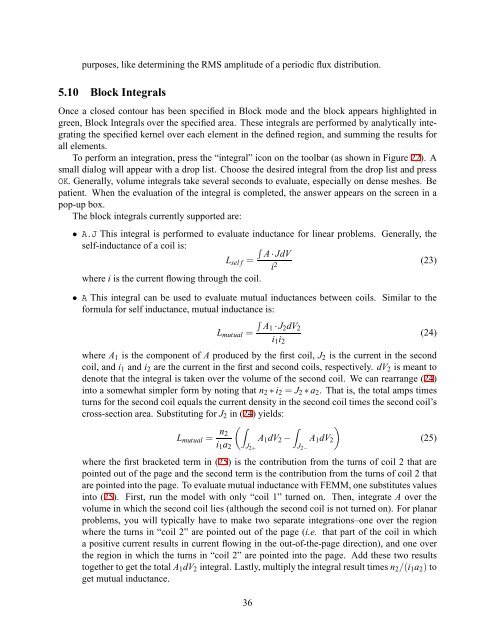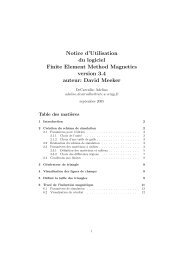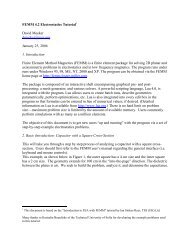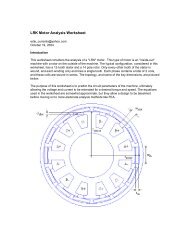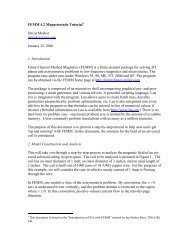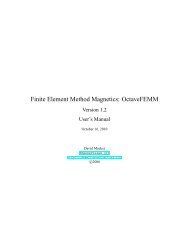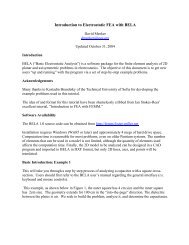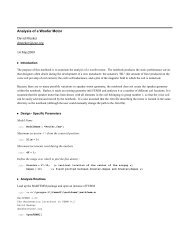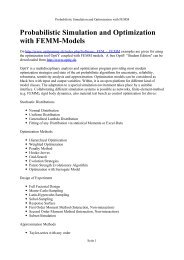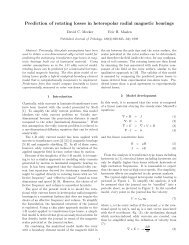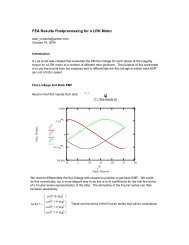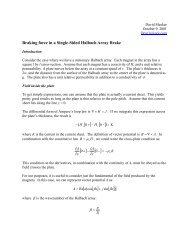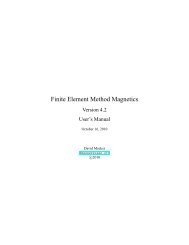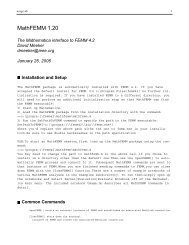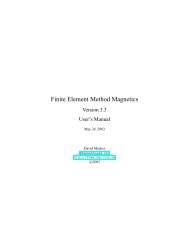1 Introduction - Finite Element Method Magnetics
1 Introduction - Finite Element Method Magnetics
1 Introduction - Finite Element Method Magnetics
Create successful ePaper yourself
Turn your PDF publications into a flip-book with our unique Google optimized e-Paper software.
purposes, like determining the RMS amplitude of a periodic flux distribution.<br />
5.10 Block Integrals<br />
Once a closed contour has been specified in Block mode and the block appears highlighted in<br />
green, Block Integrals over the specified area. These integrals are performed by analytically integrating<br />
the specified kernel over each element in the defined region, and summing the results for<br />
all elements.<br />
To perform an integration, press the “integral” icon on the toolbar (as shown in Figure 22). A<br />
small dialog will appear with a drop list. Choose the desired integral from the drop list and press<br />
OK. Generally, volume integrals take several seconds to evaluate, especially on dense meshes. Be<br />
patient. When the evaluation of the integral is completed, the answer appears on the screen in a<br />
pop-up box.<br />
The block integrals currently supported are:<br />
• A.J This integral is performed to evaluate inductance for linear problems. Generally, the<br />
self-inductance of a coil is:<br />
<br />
A · JdV<br />
Lsel f =<br />
(23)<br />
where i is the current flowing through the coil.<br />
• A This integral can be used to evaluate mutual inductances between coils. Similar to the<br />
formula for self inductance, mutual inductance is:<br />
<br />
A1 · J2dV2<br />
(24)<br />
Lmutual =<br />
where A1 is the component of A produced by the first coil, J2 is the current in the second<br />
coil, and i1 and i2 are the current in the first and second coils, respectively. dV2 is meant to<br />
denote that the integral is taken over the volume of the second coil. We can rearrange (24)<br />
into a somewhat simpler form by noting that n2 ∗ i2 = J2 ∗ a2. That is, the total amps times<br />
turns for the second coil equals the current density in the second coil times the second coil’s<br />
cross-section area. Substituting for J2 in (24) yields:<br />
Lmutual = n2<br />
i1a2<br />
<br />
i 2<br />
i1i2<br />
A1dV2 −<br />
J2+<br />
<br />
A1dV2<br />
J2−<br />
where the first bracketed term in (25) is the contribution from the turns of coil 2 that are<br />
pointed out of the page and the second term is the contribution from the turns of coil 2 that<br />
are pointed into the page. To evaluate mutual inductance with FEMM, one substitutes values<br />
into (25). First, run the model with only “coil 1” turned on. Then, integrate A over the<br />
volume in which the second coil lies (although the second coil is not turned on). For planar<br />
problems, you will typically have to make two separate integrations–one over the region<br />
where the turns in “coil 2” are pointed out of the page (i.e. that part of the coil in which<br />
a positive current results in current flowing in the out-of-the-page direction), and one over<br />
the region in which the turns in “coil 2” are pointed into the page. Add these two results<br />
together to get the total A1dV2 integral. Lastly, multiply the integral result times n2/(i1a2) to<br />
get mutual inductance.<br />
36<br />
<br />
(25)


